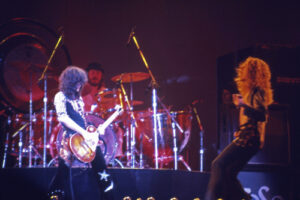
Feature Photo: William Morris Agency/Epimetheus Management, Public domain, via Wikimedia Commons
The Buckinghams formed in Chicago in 1966 under their original name The Pulsations before adopting the more British-sounding moniker. From their earliest days playing local clubs and television appearances, they gained attention for blending pop, jazz, and upbeat rock elements into “blue-eyed soul.” By 1967 they had become one of America’s fastest rising pop acts, charting five Top 40 singles in the U.S. that year alone. Their breakout hit “Kind of a Drag” shot to number one and remains their best-known song, establishing the formula that would define their mid-60s era.
Following “Kind of a Drag,” The Buckinghams continued releasing hits through the late 1960s, including “Don’t You Care” which reached number six on the Billboard Hot 100, and “Mercy, Mercy, Mercy,” “Hey Baby (They’re Playing Our Song),” and “Susan,” the latter peaking at number 11, which all helped cement their presence on the charts. Their albums Time & Charges, Portraits, and In One Ear and Gone Tomorrow all placed on U.S. charts, though with less impact than their singles. Their success in a short window made 1967 the year many fans still associate with The Buckinghams.
Despite their early momentum, the band dissolved in 1970. But in 1980 they reformed and began touring again. In subsequent years they released new studio albums including A Matter of Time (1985), Terra Firma (1998), Reaching Back (2007), and Standing Room Only (2008). They also issued Live and Well (2006) and The Joy of Christmas (2008), expanding their catalog beyond their 1960s peak. Though none of the later albums matched their chart glory, these releases kept their brand alive for longtime fans and allowed them to keep touring.
I truly believe that this is a band that was never really given enough credit for how they merged pop music and jazz Arrangements the way bands like Blood Sweat & Tears and Chicago did. They were doing the same thing, but no one ever talked about it. You will hear that in some of these songs.
# 10 -Lawdy Miss Clawdy
We open up with an entertaining version of a classic rock and roll song. “Lawdy Miss Clawdy” holds a fascinating place in the Buckinghams’ catalog because it bridges their breakthrough success with Kind of a Drag and their embrace of outside material. Written and first recorded by Lloyd Price in 1952, the song was one of the cornerstones of the New Orleans rhythm and blues sound, featuring Fats Domino on piano and Earl Palmer on drums. Its original release topped the R&B charts for seven weeks and went on to influence artists from Elvis Presley to Larry Williams. The Buckinghams’ decision to record it in 1967 came just as they were ascending the pop charts, and their version, released as a single with “I Call Your Name” and later “Makin’ Up and Breakin’ Up” on the flipside, reached number 41 on the Billboard Hot 100, number 39 on the Cash Box chart, and number 42 in Canada. Produced by James William Guercio, the track highlights how the band blended contemporary pop with the raw energy of classic rhythm and blues.
# 9 – I’ve Been Wrong Before
Now this one rocks! “I’ve Been Wrong Before,” backed with “Love Ain’t Enough,” was the fourth single released from Kind of a Drag and marked the last attempt to push a track from the album before the title song itself was issued as a single. At this point in their career, the Buckinghams were still building their identity, and while their early singles charted modestly, none had yet propelled them into the national spotlight. “I’ve Been Wrong Before” reached number 129 on the Cash Box charts, making it a minor entry that hinted at the band’s potential but fell short of breaking through.
The release of “Kind of a Drag” shortly afterward completely changed the trajectory of the group. The single shot to number one on the Billboard Hot 100 in early 1967, giving the Buckinghams the breakthrough they had been chasing. In retrospect, “I’ve Been Wrong Before” stands as a transitional single, closing the chapter on the band’s early period just before they exploded onto the national stage and became one of the most successful American pop groups of the late 1960s
# 8 -It’s a Beautiful Day (For Lovin’)
“It’s a Beautiful Day (For Lovin’)” was released by the Buckinghams in 1969, paired with “Difference of Opinion” as its B-side. By this time, the group had already experienced their major run of top ten singles earlier in the decade, and the pop music scene was changing dramatically with the rise of harder rock, psychedelic influences, and more experimental songwriting dominating the charts. The single reflected the Buckinghams’ continuing effort to deliver polished, upbeat pop material, but it struggled to make an impact on radio. The record peaked at number 126 on the Billboard charts and number 110 on the Cash Box listings, failing to achieve the momentum of their mid-1960s successes.
# 7 – Back In Love Again
Just listen to that iconic piano chord opening and the horns swing around the corner, helping the song take flight. I love the sound of the 1960s. It’s so distinct. This band has really recovered the credit they deserve for their incredible musical arrangements. “Back in Love Again” was released in 1968. Issued as a single with “You Misunderstand Me” on the B-side, the track came from their album In One Ear and Gone Tomorrow. By this point, the Buckinghams had already scored multiple top ten hits, and while “Back in Love Again” did not reach the same heights as earlier successes like “Kind of a Drag” or “Susan,” it still managed to chart respectably. The song peaked at number 57 on the Billboard Hot 100, number 53 on the Cash Box charts, and number 31 in Canada.
# 6 – Susan
It’s interesting to see how the popularity of names changes over time. In the 1960s, Susan was one of the most popular names. It’s funny, but whenever I hear the name Susan, I always think of Susan Day from The Partridge Family. I guess I’m just showing my age. I could never accept her on L.A. Law, even though she was stunning to me; she was always still associated with The Partridge Family. The record spent 12 weeks on the Billboard Hot 100, peaking at number 11 in the United States, and performed even better in international markets, climbing to number 2 in the Philippines and on Canada’s CHUM Hit Parade, number 7 on Canada’s RPM 100, and number 18 in New Zealand. It also hit number 6 on Record World’s 100 Top Pops and number 7 on the Cash Box Top 100,
# 5 – Hey Baby (They’re Playing Our Song)
“Hey Baby (They’re Playing Our Song)” marked another major moment for the Buckinghams in 1967, showcasing their ability to craft radio-friendly pop that still carried a sense of sophistication under producer James William Guercio. Written by Gary Beisbier and Jim Holvay, the song was released as a single before later being included on the band’s 1968 album Portraits. Built around an irresistible hook and polished vocal harmonies, it captured the upbeat, romantic optimism that defined much of the group’s catalog. Chart success followed quickly, with the single spending ten weeks on the Billboard Hot 100 and peaking at number 12.
The cover of Portraits by The Buckinghams is one of those images that immediately makes you stop and wonder what the concept was behind it. The band is dressed in full Civil War–style military uniforms, complete with hats, buttons, and cross belts, looking more like a regiment about to march into battle than a pop group ready to deliver chart hits. It was a strikingly unusual choice for 1967, a year when psychedelic art, bright colors, and counterculture imagery dominated album sleeves. Instead, The Buckinghams presented themselves in sepia-toned seriousness, almost as if they were frozen in a historical photograph.
# 4 – Sweets for My Sweet
The Buckinghams’ first single release was their version of “Sweets for My Sweet,” issued in 1965 as the band was just beginning to define itself within the Chicago music scene. The track, originally written by Doc Pomus and Mort Shuman, had already proven its strength through earlier versions, most notably the Drifters’ 1961 recording which hit number 16 on the Billboard Hot 100 and number 10 on the R&B chart. That version featured Charlie Thomas on lead vocals and a rhythm that leaned heavily on a Cuban-style cha-cha groove, accented by piano from Mort Shuman and supported by a remarkable cast of backing vocalists including Cissy Houston, Doris Troy, Dionne Warwick, and Dee Dee Warwick.
Two years later, the song’s endurance was cemented when the Searchers recorded their own version. Released in 1963, their take on “Sweets for My Sweet” became their debut single and reached number one on the UK Singles Chart, staying there for two weeks in August of that year. This Merseybeat-flavored interpretation was celebrated for its energy and immediacy, and it became one of the defining early British Invasion singles.
Decades later, in 1994, British reggae singer C. J. Lewis brought new life to “Sweets for My Sweet” once again with a version that combined reggae and new jack swing. His release reached number three in the UK, the Netherlands, and New Zealand, marking the song’s third major charting success in as many decades.
While the Buckinghams’ own version did not chart, its place as their debut single gives it significance in their history. It tied the group to a song that had already proven timeless, one that would continue to resonate in different eras and genres. For the Buckinghams, it was the beginning of a journey that would soon deliver them massive hits like “Kind of a Drag,” but it also linked them to a song with a lineage stretching across soul, pop, and reggae.
# 3 – Mercy, Mercy, Mercy
The Buckinghams’ version of “Mercy, Mercy, Mercy” stands as one of the most fascinating reinterpretations of a jazz composition crossing into the world of pop and soul. Originally penned by Joe Zawinul for Cannonball Adderley’s quintet, the Buckinghams brought the tune into new territory in 1967 by recording it with added lyrics written by Johnny “Guitar” Watson and Larry Williams. Their session at Columbia Studios in New York City was guided by producer James William Guercio, who helped frame the band’s polished vocal sound against the muscle of a brass-heavy arrangement. The lineup on the track included powerhouse session musicians: James Henderson, Lew McCreary, and Richard Leith on trombone, Bill Peterson and Bud Childers on trumpet, John Johnson on saxophone, Lincoln Mayorga on Wurlitzer electric piano, Dennis Budimir on guitar, Carol Kaye on bass, and John Guerin on drums. With that kind of lineup behind them, the Buckinghams created a version that felt alive with soul and punch.
What makes their rendition so memorable is how seamlessly it merges Chicago pop sensibilities with the roots of soul jazz. Released in June 1967, the single climbed to number five on the Billboard Hot 100, reached number four in Canada, and also secured a top five spot on the U.S. Cash Box chart. It gave the group another defining hit in what was already a massive year for them, proving that they could take material outside their usual repertoire and make it their own. This recording was more than just a cover; it was a reinvention that captured the band’s knack for melody and harmony while leaning on the power of some of the best session musicians of the era.
# 2 – Don’t You Care
I love the horn introduction on this one. It would be a sound that the band Chicago would use very successfully for many years. “Don’t You Care” arrived in 1967 as one of The Buckinghams’ follow-up singles, showcasing their ability to sustain momentum after their breakthrough. The track was written by Dale Carr and Lamar Vaill, produced by Jim Decker, and demonstrates the band’s tight vocal harmonies and blend of pop and soul influences. Upon release, “Don’t You Care” climbed to number six on the U.S. Billboard Hot 100. I love the melody on both the verse and the chorus. How about you?
# 1 – Kind Of A Drag
“Kind of a Drag,” released in late 1966 by The Buckinghams, became the group’s breakthrough hit and one of the defining singles of the late 1960s pop-rock era. Written by James Holvay and produced by Carl Bonafede with Dan Belloc, the track was recorded in 1966 at Chess Records studios in Chicago, the same city where the band had formed. The single featured Dennis Tufano on lead vocals, Carl Giammarese on guitar, Nick Fortuna on bass, John Poulos on drums, and Dennis Miccolis on keyboards, capturing the polished yet energetic sound that set them apart from their garage-band roots. Upon release, “Kind of a Drag” quickly gained traction, climbing to number one on the U.S. Billboard Hot 100 in February 1967, where it stayed for two weeks, and selling over a million copies. Its chart-topping success not only launched The Buckinghams into national prominence but also paved the way for a string of subsequent hits that same year,
Check out similar articles on ClassicRockHistory.com Just click on any of the links below……
Read More: Artists’ Interviews Directory At ClassicRockHistory.com
Read More: Classic Rock Bands List And Directory



































